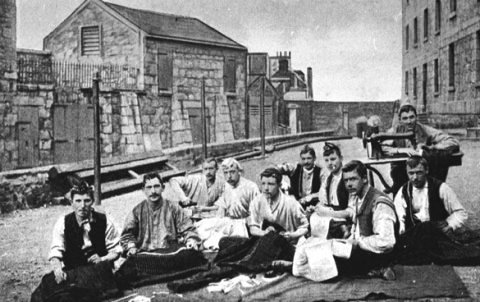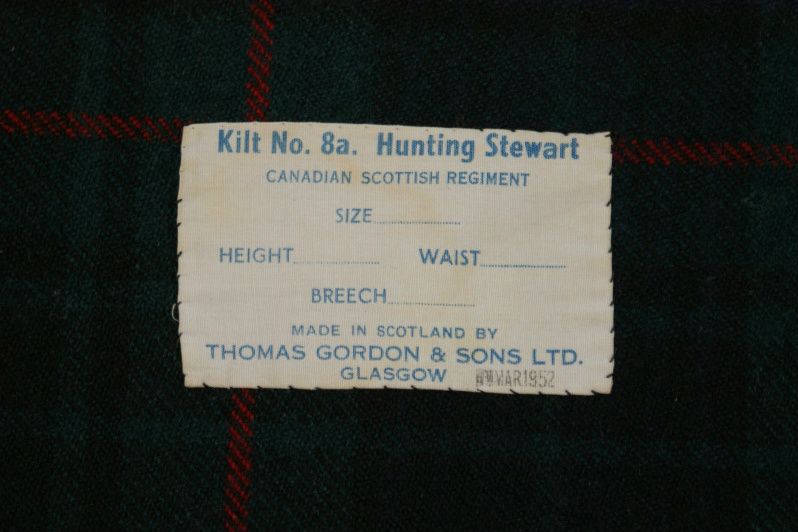|
-
16th June 16, 03:49 PM
#1
WTB: Liverpool Scottish kilt (Forbes tartan, military pattern)
I'm interested in buying a military issue kilt in good-plus condition for the Liverpool Scottish territorial battalion. They wore the Forbes tartan. Can be new/unissued or secondhand, as long as it's wearable and presentable. Large & tall sizes only; I am 6'1" tall, 185 lbs; waist needs to fit 36-38 and length 25" or a little less. I want this for historical reenactment purposes (the Liverpool Scottish were active in the world wars on many fronts) and as a tribute so men from that unit who served with the Commandos, so it does need to be military issue, not just a civilian kilt. (Most of you here will be familiar with the different material, pleating, and sett of military kilts.)
Send me details, pictures, and your price! Thanks!
"Sola Virtus Nobilitat"
-
-
17th June 16, 12:12 AM
#2
I think you will be very lucky to find a Liverpool Scottish kilt, the last ones were probably made in the late 1950s or early 1960s. Even then, they were made for young men and so the average waist would have been 30-33".
-
-
17th June 16, 12:57 PM
#3
Yes, they are hard to find. One came to eBay about a year ago but it was a shade too small. I investigated the possibility of having it altered by a reputable kiltmaker but in the end he didn't think the kilt had enough surplus material in it to work with, and dissuaded me from wasting time and money on the attempt.
I saw the TA unit, with pipe band, kilts in evidence, marching in Liverpool in the late 1980s; I'm not entirely certain if it's status now is active enough to allow for issuance of MOD clothing that isn't regarded as combat-essential. So how long has it been since a batch of regimental Forbes kilts were made? And would the material be the same? Modern army tartan doesn't seem to be at all like what I have seen in the past (e.g., the Thomas Gordon firm that is credited in so many older kilts). I need to also make inquiries among Canadian contractors and see what is being provided to the kilted Canadian reserve units.
"Sola Virtus Nobilitat"
-
-
17th June 16, 03:04 PM
#4
OK, because you asked.
I am Regimental Kiltmaker to The Canadian Scottish Regt. here in Victoria. The current kilts I make for them are made from newly woven fabric in 16oz weight.
I also own a current RRS kilt. It is a hand finished, machine sewn kilt also made from 16oz weight fabric.
As a Docent at the Royal BC Museum I have access to many kilts made prior to and during WWI. While the fabric is generally coarser than that woven today the weight is not the mythical 22 oz stuff that everyone seems to think of. I have weighed these kilts and the fabric varies between 15oz and 19oz.
I have also noticed a marked difference between an officers and an enlisted kilt. In general officers had their kilts custom made. Usually by one of the Scottish based kilt shops but not by those holding the military contracts. I have seen and held two made of very heavy silk. Most of the other officer's kilts are made from far finer woven, lighter weight, Merino wool.
I also notice that there is no one, single standard way to make these older kilts. Some have the elastic loops in the back of the pleats used for parade occasions. Some are machine sewn except for the Fell area. One was hemmed from fabric that does not have a kilt selvedge. I have seen just about every type and method of closure imaginable. One had no fasteners and was obviously pinned as evidenced by the holes where straps and buckles would be today. One had a single long strap that went all the way from the under-apron edge - around the back - to a buckle on the outer apron edge. In almost every case where the two prong buckles were used the straps have been perforated so many times that they have failed like a sheet of paper toweling.
There is also a wide range of quality to the manufacture, the thread used, and the stitching. I have held two kilts with Scottish Contract labels in them where the stitching is of a very heavy, thick stuff almost like yarn. The stitches are huge and are plainly visible from across the room.
I am a believer that "The proper military issue kilt" is a myth. I've seen far too many examples and far too many differences in military kilts to be able to say what a 'proper' kilt would actually be.
There is a very famous photo of The Gordon Highlanders sitting around outside their barracks making their own kilts. There is plainly a sewing machine in the picture. It would seem that there was no single regimental kiltmaker available and that this unit did not get its kilt from a contracted kiltmaker.

If you are looking for a kilt from the period when kilts were worn in combat you will need to find one from WWI and kilts like this are usually in museums and private collections. I don't remember ever seeing an actual WWI era kilt on EBay going for less than antique prices.
But good luck and keep us posted.
Last edited by Steve Ashton; 17th June 16 at 03:15 PM.
Steve Ashton
www.freedomkilts.com
Skype (webcam enabled) thewizardofbc
I wear the kilt because: Swish + Swagger = Swoon.
-
The Following 3 Users say 'Aye' to The Wizard of BC For This Useful Post:
-
17th June 16, 03:09 PM
#5
And because you mention Thomas Gordon and Sons here is a label from a kilt made by them dated Mar 1952.
This kilt is made from fabric very similar to that found today. 16oz.

The internal stitching used cotton thread that had simply rotted over time. This caused the kilt to fall apart because the internal elements were not of the quality and level of manufacture we see today.
Here is what the kilt looked like when it came to me.

Please notice that the buckles had been replaced and the black band on the top of the kilt had been oversewn with a light green twill tape to simulate the dark green banding used after WWII.
In general, the fabric itself was in pretty good condition. The top banding and all the internal elements had rotted.
Last edited by Steve Ashton; 17th June 16 at 03:26 PM.
Steve Ashton
www.freedomkilts.com
Skype (webcam enabled) thewizardofbc
I wear the kilt because: Swish + Swagger = Swoon.
-
The Following User Says 'Aye' to The Wizard of BC For This Useful Post:
-
17th June 16, 09:54 PM
#6
 Originally Posted by The Wizard of BC

As a Docent at the Royal BC Museum I have access to many kilts made prior to and during WWI. While the fabric is generally coarser than that woven today the weight is not the mythical 22 oz stuff that everyone seems to think of. I have weighed these kilts and the fabric varies between 15oz and 19oz.
I understand that the mythical 22oz stuff was the heavy ORs' cloth woven with a Cheviot yarn. The weight referred to a linier yard but I don't know if this was single or double width, the former I suspect, nor what width either was. The width may have been other than the modern 28/54 inch standard.
-
The Following 2 Users say 'Aye' to figheadair For This Useful Post:
-
17th June 16, 10:23 PM
#7
You may be correct Peter. I simply do not know how the old stuff was done.
I do know that when I weigh fabric I compare it to today's fabric. One linear yard (36 inches) by 60 inches wide.
This I call a fabric yard as compared to a kilt yard which is the length of the fabric used to make the kilt regardless of its width.
So, one fabric yard would be 60"X36" or 2160 square inches. (that's 13935.46 square cm)
To determine the weight of the fabric used in a kilt I measure along the hem. This gives me the kilt length. Then multiply that by the total width (drop + rise) of fabric used in the kilt.
So let's say as an example only that I have a kilt that is made from a kilt length 288 inches long and is a total of 26 inches wide. 288"X26"=7488 square inches.
7488/2160=3.466 fabric yards. If the total weight of the kilt is around 65 to 67 ounces I would know that the kilt is made from 16oz fabric. (accounting for 10oz which is the approx. weight of the interfacing, stabilizer, lining, straps & buckles and thread.)
If I use the same standard all the time it gives me a pretty good comparison between the modern fabrics I use everyday and any other kilt that I run across.
(and by the way, and only for comparison - the modern kilt fabrics that I have used weigh between 14.2oz and 18.1oz using this method even though sold as 16oz. So there is no real standard and everyone is a bit different.)
Steve Ashton
www.freedomkilts.com
Skype (webcam enabled) thewizardofbc
I wear the kilt because: Swish + Swagger = Swoon.
-
The Following 5 Users say 'Aye' to The Wizard of BC For This Useful Post:
Tags for this Thread
 Posting Permissions
Posting Permissions
- You may not post new threads
- You may not post replies
- You may not post attachments
- You may not edit your posts
-
Forum Rules
|
|





















Bookmarks